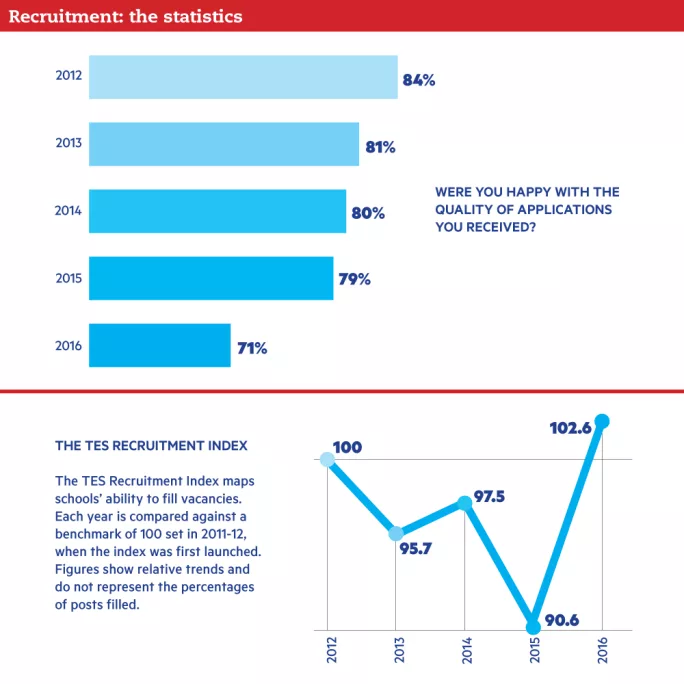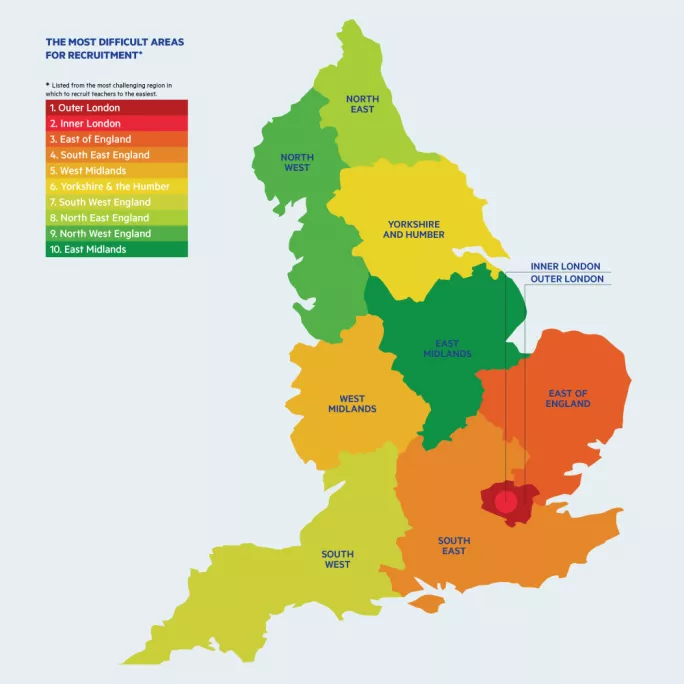We’re being forced to hire worse teachers, say heads

Headteachers are increasingly unhappy with the quality of applicants for teaching posts, TES research shows, as heads’ leaders said schools are being forced to take on lower calibre staff in a desperate attempt to fill positions.
New figures reveal that schools have had more success filling empty roles than in any other year since 2012 but, according to heads, there has been a fall in the quality of applicants over the same period.
The annual TES Teacher Recruitment Index research shows that almost three-quarters of school leaders - 72 per cent - believe there has been a “deterioration” in the quality of applicants for vacant posts since the previous year.
The data comes after heads’ leaders warned that the recruitment crisis was the “most severe challenge facing the education system today”.
The TES index also reveals that:
* More than half of heads were cutting “non-core” subjects from their schools’ curricula;
* Two-thirds of heads and teachers said class sizes had increased this year;
* Three-quarters of teachers were increasingly being asked to teach subjects they were not qualified in;
* Nearly four in 10 teachers said that a greater number of support staff were taking classes in their schools.
Perhaps most worrying, however, was that headteachers reported a drop in the quality of teachers they were employing, despite all regions of the country reporting an overall increase in the rate at which they were filling vacant posts.
Heads need to have teachers, so, when push comes to shove, you have to fill the vacancy
Since 2012, heads have been increasingly dissatisfied with the “calibre of candidates” for teaching jobs, the study shows. This year, 71 per cent of heads said they were happy with the quality of applicants, compared with 84 per cent in 2012.
John Howson, a teacher recruitment expert and visiting professor at Oxford Brookes University, said that there was always less choice in recruiting teachers when the economy was coming out of a recession, as high-quality graduates found jobs in other professions.
‘Pay is critical’
And he warned that the government needed to look at teachers’ pay if it was to tackle the recruitment crisis.
“The School Teachers’ Review Body has said the government needs to do something about pay before the end of this Parliament. They are saying that pay is impacting on both recruitment and retention,” he said. As one principal commented, “If you pay peanuts, you end up with primates” (see box, below).
Ministers have repeatedly stated that the number of teachers in schools is at an “all-time high”, and have been reluctant to acknowledge that schools are facing a teacher supply crisis.
However, school standards minister Nick Gibb said this week that the Department for Education was looking at how to get more “granular detail” on vacancies, including carrying out an annual survey of a sample of schools.
But Malcolm Trobe, interim general secretary of the Association of School and College Leaders, said that government figures were currently “disguising the reality” of the recruitment and retention crisis as schools were being forced to fill roles with “supply staff or people who were below the usual standard”.

It was clear that heads were reporting a drop in the quality of applicants, which will have a knock-on effect on schools’ performance, he added. “All of the information we have ties in with that. Headteachers need to have people in front of the classroom, so when push comes to shove, you have to fill the vacancy,” Mr Trobe said.
His comments echo those of Ian Bauckham, executive head of the Bennett Memorial Diocesan School in Kent, who told TES earlier this month that it was not possible to run a school on “absolute vacancies”.
“You have to have someone in. So you play with whatever you can - they may not be a qualified teacher. There is a hidden vacancy rate,” he said.
According to the study, the geographical areas where schools are finding it most difficult to attract staff remain both inner and outer London.
The data also suggests that schools should think about offering more part-time roles. Of the teachers surveyed who recently left the profession, 77 per cent said that they would consider returning on a part-time basis.
You have to have someone in - they may not be a qualified teacher
The TES research reveals that heads are being more creative in the way they recruit staff, with more than half - 54 per cent - stating that on occasions they would hire more than one candidate applying for a job if they were sufficiently impressed by them.
Heads are also having to be more flexible with the roles they are offering, with 82 per cent stating they had changed a role they had advertised to ensure they filled it.
Russell Hobby, general secretary of heads’ union the NAHT, said school leaders had to put someone in front of the class. And he added that the recruitment and retention crisis was the “most severe challenge” facing education today.
“There is one silver bullet that can raise standards in schools and that is great teachers. But if you don’t have great teachers, you will not get a great education system,” Mr Hobby said.
A DfE spokesperson said: “More than 97 per cent of teachers have a degree or higher - up from just over 94 per cent in 2010 - and the number of teacher trainees with a first has almost doubled over the same period.
‘The toughest place to find staff’
Schools in outer London find it more difficult to fill teacher vacancies than those in any other part of the country, the TES data shows (click here to view).
Headteachers in the boroughs just outside the centre of the capital face significant competition from schools in inner London, which are able to pay higher salaries.
According to Professor John Howson, schools on the outskirts of London in areas with good transport links into the capital are most likely to face challenges attracting staff.
Inner London was the second hardest area in which to recruit teaching staff, just ahead of the East of England, which has leapfrogged the South East for the first time since 2013.
Professor Howson said the East of England had the lowest number of trainees per 100,000 teachers. “If you look at Suffolk, it has no university and has a limited number of school-centred initial teacher training (SCITT) networks,” he said. “But at the same time, the population around Ipswich is growing fast.” The area where heads had least difficulty recruiting teachers was the East Midlands.

You need a Tes subscription to read this article
Subscribe now to read this article and get other subscriber-only content:
- Unlimited access to all Tes magazine content
- Exclusive subscriber-only stories
- Award-winning email newsletters
Already a subscriber? Log in
You need a subscription to read this article
Subscribe now to read this article and get other subscriber-only content, including:
- Unlimited access to all Tes magazine content
- Exclusive subscriber-only stories
- Award-winning email newsletters